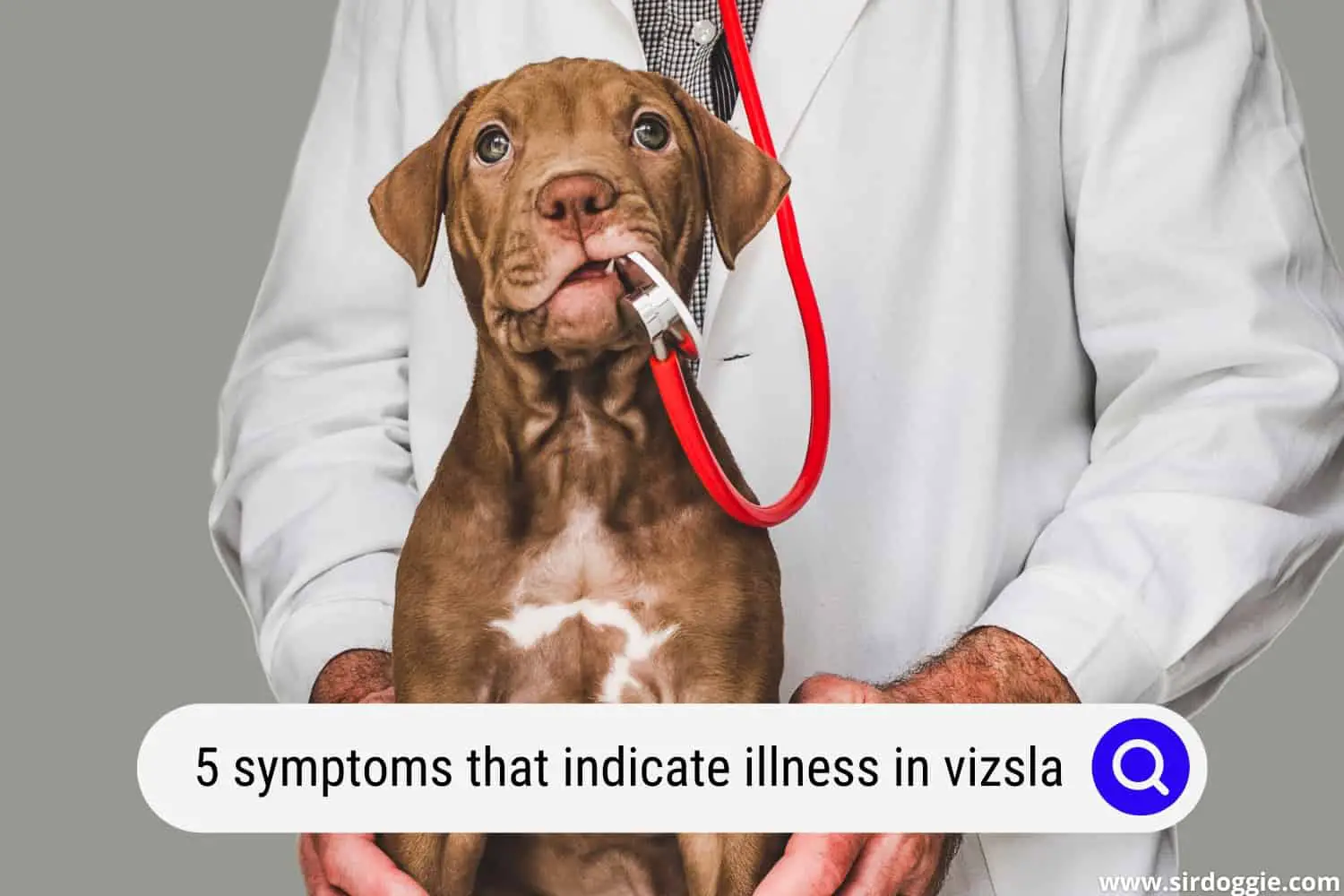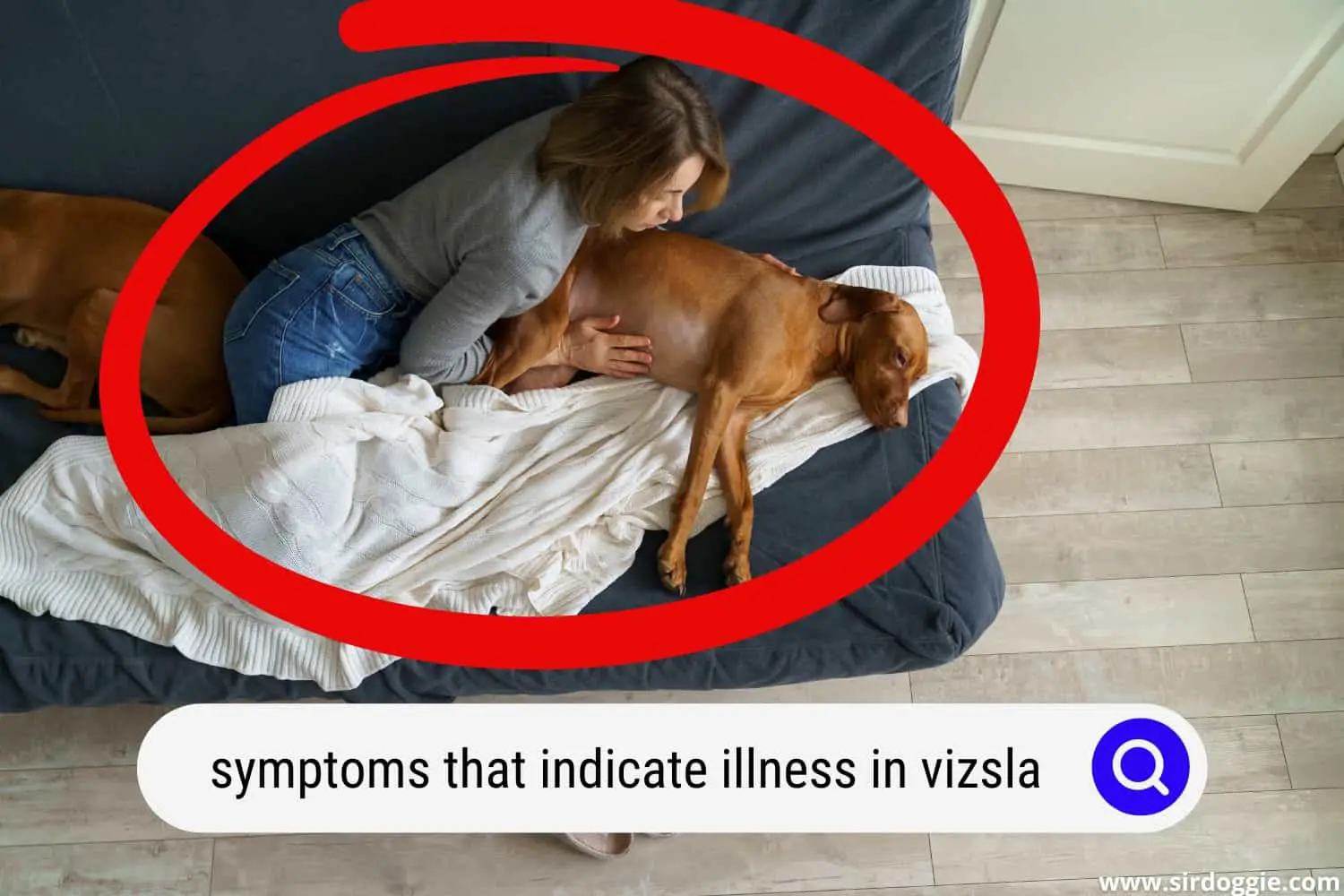Five Symptoms That Indicate Illness In Your vizsla
Vizsla’s, just like other dog breeds, also have their fair share of health issues that made them prone to some illnesses. Their health problems can be because of genetics and as a result of some inbreeding that occurred. Also, even if we follow a correct diet and exercise for them, some health problems still arise.

Here are 5 symptoms that indicate illness in our Vizsla.
1. Difficulty in walking
You will notice your dog limping and having difficulty lying down and getting up. He also cannot perform some activities considered common, such as running and walking properly.
Possible Medical condition
Hip and elbow dysplasia is an inherited disease where improper development of joints leads to arthritis. Your dog will manifest stiffness, most especially in the elbow and hips. Your dog will experience some pain and absolute discomfort during this episode.
Diagnosis and Treatment
Arthritis is treatable and should be diagnosed at the earliest time so that the health problem will be addressed the soonest time. Surgery can also be an option depending on the severity of the dog’s illness. The weight of your Vizsla also contributes to this illness besides his age and diet. Treatment includes good nutrition and proper exercise, do not let your Vizslas get overweight as this is a contributing factor to arthritis.
Patchy, crusty, and scaly skin.
If you notice your Vizsla scratching excessively and at the same time biting at his paw or the base of his tail, this may be a symptom of mange. Most of the time, their skin will turn red and scaly and there is crust forming on his skin. There is also the appearance of rash and alopecia (absence of hair partially or completely).
Possible Medical Condition
Mange infection is the common cause of why your dog suddenly scratches excessively, which results in a patchy, reddish, and scaly skin. There are 2 types of mange which are the demodectic mange that occurs in a dog with a weak immune system and usually happens when they are young and less than a year old, sarcoptic mange, on the other hand, is also known as scabies and is also a danger to humans.
Diagnosis and Treatment
With the first symptoms of excessive scratching and paw biting, immediately bring your vizsla to the vet for proper diagnosis. Some Demodectic mange can go away by itself once your dog reaches a mature age, but most vets will give treatments such as oral medication or topical spray and ointment. If your dog’s health is compromised because of the mange, an antibiotic will be prescribed by the vet as well.
Sarcoptic mange, on the other hand, needs a distinct treatment combination to fight off the harmful mites. All the beddings of the dogs removed, thrown out, or thoroughly washed. Since sarcoptic mange is also contagious for other dogs (and humans!), all the other dogs should also undergo treatment.
2. Difficulty, swallowing
You may notice your Vizsla having difficulty swallowing food that you used to feed him and suddenly he loses interest in it. There is a struggle to swallow even a tiny bit of food.
This may sometime show a muscle disease called Polymyositis. Symptoms include difficulty in performing everyday activities such as picking up food, licking, lapping, or anything that involves using his tongue muscles is compromised. This can be acute or chronic where for other dogs it will be quickly treated while for some dogs it is a kind of long-term illness.
There are also episodes of gagging, dysphagia, retching, and hypersalivation (excessive production of saliva). You will notice messy eating and unusual drinking pattern, sometimes you may also notice your dog not drinking any of his water at all.
Treatment and Diagnosis
Upon noticing changes in your dog’s eating and drinking pattern, it is best to bring him to the vet for prompt diagnosis and treatment.
Vizslas will be carefully monitored and will be given immunosuppressive drugs like Prednisone and Azathioprine plus gastro protectants. Some vets are introducing Atopica which is another immunosuppressant meds. If your dog is receptive to the treatment, he will then be prescribed a maintenance dose of steroids. Hungarian Vizslas can get through this illness with the right diagnosis, treatment, and lots of TLC.
Vomiting with blood
It is frightening to see your dog vomiting blood (hematemesis) because 80% of this sign means there is something wrong with your dog. You should also try to check what blood he vomited and its consistencies – is it clots of blood, red and fresh, or blood that is tarry.
3. Possible Medical Conditions
Stomach Cancer
Most of the stomach cancer in dogs are already malignant when diagnosed. As owners of dogs, you should be wary and observant of your dog’s behavior because early detection is a must.
Tumors that are found in the esophagus or stomach. If diagnosed early in the disease, there is a possibility that surgery can still be done to your Vizsla and if it is diagnosed as benign or non-cancerous, surgery is the recommended treatment.
If in case the tumor found is malignant, two options will be chemotherapy and radiation therapy.
Ulcer
There are many reasons ulcers happen to your Vizsla some of which are excessive acid in the stomach, high in fat diet, chronic gastritis, exposure to certain drugs, etc.
Treatment will depend on the severity of your dog’s condition where if perforation of the stomach wall is present, surgery is recommended
For some instances, Veterinarians will prescribe antacids and change in diet. Your dog will have to stick to a low-fat diet and a low-sodium diet. There are also natural treatments for ulcers in dogs where supplements are mostly prescribed to treat the ulcer.
Gastritis
Acute gastritis in your vizslas, which can last in less than 24 hours. Sometimes causes are spoiled food, ingested foreign objects, toxins, or overfeeding. Some dogs may recover shortly after the appearance of symptoms while other dogs recover in 2 to 3 days with supportive treatment.
For chronic gastritis, your dog will undergo blood tests, abdominal ultrasound, and endoscopy, as well as other laboratory tests as needed.
Treatment usually involves the withholding of food for 1 to 2 days, the liquid is allowed most especially if the vomiting stops. Resumption of feeding will depend on the reduction of vomiting, or if vomiting stopped altogether. Your Vizsla will be given anti-emetic (anti-vomiting) meds and ulcerative meds.
Clotting disorders
Vizslas are more prone to rare diseases of the blood such as Hemolytic Anemia and Thrombocytopenia where the dog’s own immune system destroys red blood cells. Your dog will have abnormal bleeding, and there is a sudden appearance of bruises. Their gums will appear pale instead of the ideal pink in color.
Treatment will usually depend on what the veterinarian’s diagnosis will be and if your Vizsla will also need a blood transfusion or surgery. However, to slow the destruction of red blood cells by the dog’s immune system, vets will prescribe Immunosuppressive drugs and steroids. Prognosis is good as long as early examination and treatment are performed for your Vizsla.
Von Willebrand’s disease is also a blood-clotting illness that is mostly found in Vizsla breed. Veterinarians will perform a specific diagnostic test for Von Willebrand’s disease, veterinarians will give the necessary meds or even surgery if needed, and once there is a confirmatory diagnosis.
4. Watery, cloudy, and squinty eyes
You should notice your vizsla is suddenly uninterested in playing outside and has a loss of appetite. You will also see redness in your dog’s eyes and frequent squinting. Your dog may even be in pain without you noticing it.
Possible Medical condition
Glaucoma may be the cause, and there is a danger of vision loss in your dog. There is a possibility of irreversible damage when no proper diagnosis and treatment are given.
Diagnosis and Treatment
You should quickly bring your dog to the veterinarian once you see the symptoms mentioned above, the vet will do some diagnosis to confirm the condition of your dog. One way to check your dog’s illness is by using a Tonometer and another is by X-ray.
Treatment will depend on the severity of your dog’s eye condition. Once the eye fluid in your dog’s eye is draining correctly, they will give him some medications or topical drops and ointments. There will be medication to lessen pain for a period. Surgery is sometimes another option and will depend on the degree of your dog’s eye damage.
If your dog’s condition is not caught on early, there is a probability that he will go blind. Glaucoma in dogs may have one or both eyes affected. The veterinarian should examine both eyes.

5. Cataracts
Opacity in the eyes is another symptom that you will observe in your Vizsla or some sort of cloudy film that is covering the lens of your dog’s eyes. Some dogs can live well with one eye going blind or both, but don’t make things difficult for your dog and have him checked immediately.
Mostly, adult Vizsla dogs have this illness and may cause their blindness. Treatment can be surgery to remove cataracts, and restoring his eyesight may still be possible.

Family Dog Expert Author
Hi there! I’m Stuart, a devoted dog lover and family dog expert with over a decade of experience working with our furry companions. My passion for dogs drives me to share my knowledge and expertise, helping families build strong, loving bonds with their four-legged friends. When I’m not writing for SirDoggie, you’ll find me hiking, playing with my beautiful dog, or studying music.